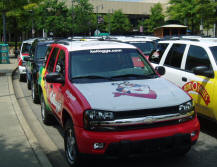
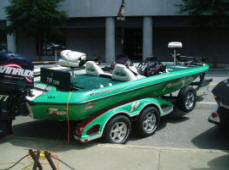
Vinyl Siding
Wraps Are Second Skins,
Plus Moving Billboards
Monday, December 19, 2005
BassFans have heard a lot about boat wraps over the past few months, particularly since BASS made a sponsor wrap one of the requirements for the new Bassmaster Elite Series. In the simplest terms, a wrap is a big decal that transforms a bass boat into a traveling, floating billboard.
A wrapped boat stands out like a strutting peacock in a pen full of fryer chickens. Visually, the difference between an unwrapped boat and a wrapped one is akin to the difference between the Chevy Monte Carlo you see on your daily commute and the rig that Jeff Gordon drives in Nextel Cup races.
Their combination of bright colors and splashy graphics grab your attention, and they keep it for awhile. Think about it – when was the last time you saw a wrapped boat and didn't check to see who the sponsor was? It doesn't happen.
Some companies – both inside and outside the fishing industry – are firm believers in this form of advertising and have entered into contracts with anglers for an annual amount that's similar to a 1st-place check in a tour event. Others have yet to embrace it, perhaps with the notion that logo recognition alone won't result in enough additional sales to offset the expenditure.
But what exactly is a wrap? And how do you measure its reach?
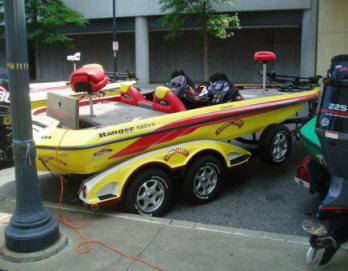
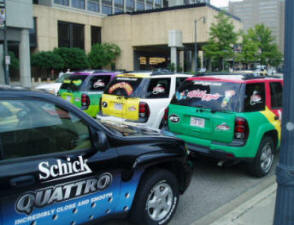
The What, How and How Much
Joe Naponeillo of Chicago is a tournament angler who's the owner and president of Sign Options. Among other things, his company designs and installs wraps for bass boats and tow vehicles.
He said a wrap is a multiple-part component system that consists of adhesive-back cast vinyl, ink and a cast laminate. The ink is applied directly to the vinyl and the laminate provides the protective outer shell.
Some companies, depending on the boat model, will apply a wrap in just one piece. Naponeillo will overlap as many as six. "If we do the boat in-house, we try not to use one big piece because we don't think it comes out looking as good," he said. "But there are some manufacturers who think one piece looks better."
He used a Ranger Z21 as an example of a six-piece job. On each side, he'll install the stern piece first, followed by a large piece that goes to the first big curve (about 60 percent forward). The final piece comes up 3 inches shy of the nose. "You have to come up short because the wrap can't hit the roller eye-bolt," he said.
In addition to protecting the graphic elements, the laminate also secures the boat's original finish. "It's very, very durable," he said. "I had a wrap on my own boat for 2 1/2 years and I fished EverStarts, other FLW events and some BASS events. When I took it off, the boat looked brand new."
Tour pro Ray Scheide, who does wraps at his sign shop in Russellville, Ark., agreed. "It's like a second skin," he said. "It's very thick and scratch-resistant. You can run it through trees or stumps or whatever and it's still pretty hard to tear.
The price of a boat-wrap job varies by company. Estimates usually run between $2,500 and $4,000.
"The biggest factor in price is that vinyl is a petroleum byproduct, and we've seen cost increases anywhere from 40% to 300%," Naponeillo said.
What Does
the Sponsor Get?
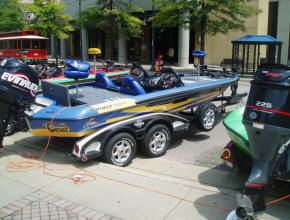
There's one thing a company can be assured of if its logo adorns a full-time tour angler's boat: that logo will be seen by millions of people. Depending on where he lives, an angler logs many thousands of highway miles per year with his boat in tow.
For several years, Arizona tour pro Jarrett Edwards has sold signage on two large fish tanks used at outdoors shows. He recently signed a wrap deal with Lowrance.
"When you see a wrapped boat, it makes you do a double-take," he said. "It's unique and it catches your eye and you want to see what it says. The only thing is, I think some companies might still be a little bit intimidated by the idea because they don't know how it works."
Pete Galbiati, director of sports marketing for JDC Marketing Group of Atlanta, was involved with the formation of the now-defunct Team Crown Royal that included Aaron Martens, Skeet Reese, Peter Thliveros and Mike Wurm. In all, there were 14 Crown Royal boats traversing the country.
He cited figures from federal transportation studies that claim a wrapped vehicle generates 1.2 million impressions per month. "With 14 of them, that was 200 million drive-time impressions a year," he said.
A wrap was the least expensive, most impactive form of advertising.
With the help of figures compiled by NationalBillboards.com, he calculated his impression estimates not by miles, but by time. "A wrapped vehicle is something that you can't turn off," he said. "It's on 24 hours a day, 7 days a week, and I always made sure I parked it in places where it could be seen."
He came up with a total of 147 million impressions a year. "It would have cost over $3 million to purchase that much advertising on TV," he noted.
He also said the word "sponsorship" doesn't really pertain to a wrap deal. "What we need to sell companies on is the entire marketing package. Pro fishing is just the vehicle. The wrap is the thing."
Notable
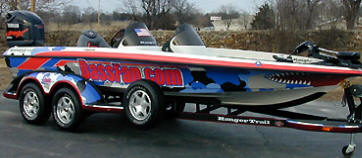
> Many variables must be considered to determine an in-shop time estimate for a wrap job. Scheide said it takes three well-trained workers about 4 hours to apply a one-piece wrap to a boat. Naponeillo said two workers would need 2 to 3 days for a six-piece job.
> Scheide said a wrap can be easily repaired if it's torn during the season, but such occurrences are now rare. "Things have improved after several years of testing, and you hardly ever see a boat with half a wrap hanging off anymore."